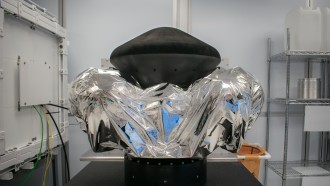The Hubble Space Telescope will be celebrating its 26th year since its launch on April 24, 1990 and, while some of the grander images of space it allowed humanity to see are displayed in the Hall of Fame as part of the celebrations, let us commemorate its contributions for more than two decades this time around.
When you read or hear the name "Hubble Space Telescope," the first thing you would most likely imagine are better defined images of the planets in our galaxy or visions of nebulas millions of light years away that your ordinary telescope cannot even detect.
But the Hubble Space Telescope was not just a great idea that the National Aeronautics and Space Administration (NASA) decided to work on and successfully launch. The project, from the very idea, took decades to accomplish and experienced many bumps along the way. One of the biggest bumps was, of course, the financial aspect.
The Idea
Humans have always had a fascination with space and the heavenly bodies and there have been breakthroughs with the way we understand celestial bodies even with just pure observation or, in the more "modern" 16th to 18th centuries, early telescopes. In order to find out more about what lies beyond the Earth's atmosphere, telescopes were built bigger and situated higher -- one such giant telescope is the Hooker Telescope on Mount Wilson -- which the noted Astronomer Edwin Hubble used to discover that the Andromeda is a galaxy and not a mere nebula, among other things.
In spite of his many discoveries using only the Hooker Telescope, all astronomers were of the opinion that many more discoveries can be made if only they had a clearer view of space -- they knew that the clouds and dust in the Earth's atmosphere caused inconsistencies with observations.
The Beginning
It was in 1923 when German scientist Hermann Oberth wrote about the possibility of sending a telescope out in space but it was not until 1946 that his idea received a very well written support courtesy of Princeton astrophysicist Lyman Spitzer who wrote about the scientific benefits of such an idea.
The Delay
NASA launched two Orbital Astronomical Observatories (OAOs) after 1957 but its capabilities were limited and it was not until 1969 that the National Academy of Science approved the Large Space Telescope (LST) project. If you thought that was it then you are mistaken. After the approval, there were more studies done in order to determine the feasibility of the project. For years after that, that was mostly what could be done because of budget constraints.
It was not until 1974 that the LST Working Group figured out a way to go around the budget constraints by suggesting that the telescope be equipped with interchangeable instruments. This was because the working group needed to figure out a way to downsize the telescope to decrease the cost but still keep it well-equipped to prevent it from losing its scientific value.
The Turning Point
The project still needed funds or parts to actually be able to make the improved telescope and that is where the European Space Agency (ESA) stepped in. In 1975, the ESA decided to join the project and take care of 15 percent of the funding by providing the Faint Object Camera (FOC), an integral part of the LST. In return, ESA was guaranteed 15 percent telescope time - that is ESA's astronomers will be allowed to use the LST 15 percent of the total time during its operation.
In 1977, Congress finally approved funding for the LST and this is when Hubble began to take shape.
The Hubble As We Know It
In order become more efficient, NASA and its contractors had to build a space shuttle that can take off, leave satellites in orbit and come back down to Earth for reuse.
The Hubble Space Telescope would have celebrated its 26th year in space a few years ago but its original 1983 launch was delayed because the people involved underestimated the cost for building and maintaining the large Cassegrain reflector telescope. It was finally fully built and ready to launch by 1985 but the Challenger accident in 1986 halted the project. However, this also forced the group to reconsider the LST's construction at that time and make improvements in possible weak areas.
By April 1990, the LST was finally ready to go and both NASA and ESA finally launched the fruit of their partnership and labor. From then until now, Hubble has made more than 1.2 million observations and is the source of thousands of studies that led to hundreds of new discoveries about space.
The Future Of Astronomy
It is safe to say that the launch of the Hubble Space Telescope is much like the Apollo 11 mission for astronomers. It will not stop with Hubble because more powerful telescopes will be launched by 2018 and mid-2020s but Hubble definitely made its mark for humanity.
Here's a bonus photo of one of the ways Hubble sees the Universe.








